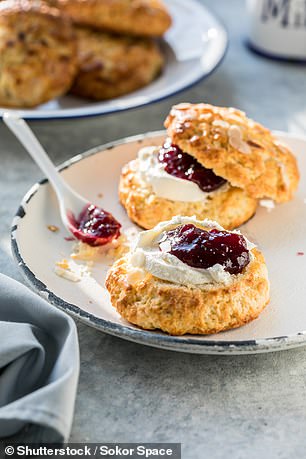It has been one of the most hotly debated topics in the UK since the early 1500s.
When it comes to scones, should you put the clotted cream or the jam on first?
People from Devon are adamant that the cream belongs on the bottom, yet Cornish residents maintain that the jam should be slathered on first.
And afternoon tea lovers across the rest of the UK are torn on who to side with.
To help settle the debate once and for all this Afternoon Tea Week, we spoke to three food scientists – so, do you agree with their methods?


It has been one of the most hotly debated topics in the UK since the early 1500s. When it comes to scones, should you put the clotted cream or the jam on first?
Scones are thought to have originated in Scotland back in the early 1500s and have since become a staple feature on any decent afternoon tea.
Cream tea – consisting of tea, scones, clotted cream, and jam – is particularly popular in both Devon and Cornwall.
But despite being just a matter of miles apart from one another, these counties have very different opinions on how cream tea should be consumed.
People in Devon argue that the clotted cream acts like butter, and therefore should go on the scone first.
In contrast, people in Cornwall see the clotted cream as more of a topping, much like squirty cream, and so argue it should go on the scone last.
In the hopes of getting to the bottom of the debate, researchers from the Centre for Industrial Rheology conducted a scientific experiment to assess the spreadability of clotted cream and jam.
Their analysis revealed that clotted cream is more viscous and rigid than jam, which means more effort is required to induce movement.
For this reason, the researchers claim that Devon has got the order right.
‘The only logical conclusion from this casual study is that to have a good, rigid, base for the jam the clotted cream needs to be applied to the scone first,’ the researchers explained.

In the hopes of getting to the bottom of the debate, researchers from the Centre for Industrial Rheology conducted a scientific experiment to assess the spreadability of clotted cream (blue) and jam (red). Their analysis revealed that clotted cream is more viscous and rigid than jam, which means more effort is required to induce movement
However, beyond spreadability, Cristiana Solinas, Head of the National Bakery School at London South Bank University, claims that several other factors need to be considered.
Speaking to MailOnline, Ms Solinas explained: ‘The texture and consistency of both the jam and cream will contribute to how the scone feels when chewed.
‘Jam might add a sticky or smooth feel, while cream might add a rich, velvety sensation.’
According to Ms Solinas, it’s not the order of the cream and jam that matters – it’s the ratio.
‘The proportion of jam to cream is obviously more important than the order in which they are eaten as they bring different texture/flavours to the experience,’ she said.
‘Imagine a very sweet jam or one that has a bittersweet aftertaste. You wouldn’t want too much of those, would you?
‘The almost “neutral” flavour of the cream would balance that out, but up to a certain point.
‘A balanced ratio might create a harmonious texture, while too much of one could overwhelm the other, affecting the overall mouthfeel and taste.’
Ms Solinas also claims that the freshness of the scone itself plays a crucial role in the overall experience.
‘A fresh scone will be soft, slightly crumbly, and likely warm, which can definitely enhance the whole experience,’ she told MailOnline.
‘Conversely, a stale or dry scone might negatively impact the texture and taste, regardless of the jam-to-cream ratio.’
When pushed on which topping order she prefers, Ms Solinas says that the people of Devon have got it right.
‘What is important to me is how it looks,’ she added.
‘Why would you hide a nice vibrant red strawberry jam under the pale white cream?!’
However, not everyone agrees.
If you prefer the Cornwall method, you’ll be pleased to learn that Professor Charles Spence, Professor of Experimental Psychology at the University of Oxford, has got your back.
Speaking to MailOnline, he said: ‘I would think it is best to show cream on top of jam.
‘Our brains are drawn to energy density and cream is more energy dense than jam.
‘Also, it is the mouth-coating sensation we really like with creamy and oily foods, so best get that in there first.’
As to whether the order really matters at the end of the day, Professor Spence claims that ‘more research is needed.’
‘Rituals around preparation and consumption can enhance the experience of eating and drinking,’ he concluded.
‘As to whether it matters from a taste perspective, I suspect it is a case of more research needed!’

